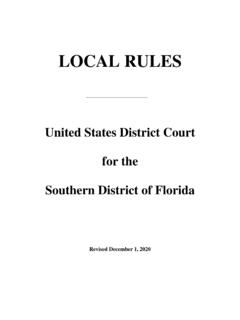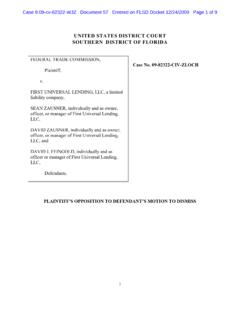Transcription of The Fifth Circuit Four: The Unheralded Judges Who Helped ...
1 The Fifth Circuit Four: The Unheralded Judges Who Helped to Break Legal Barriers in the Deep South Max Grinstein Junior Division Historical Paper Length: 2,500 Words 1 For thus saith the Lord God, how much more when I send my four sore judgments upon Jerusalem, the sword, and the famine, and the noisome beast, and the pestilence, to cut off from it man and beast. 1 In the Bible, the Four Horsemen of the Apocalypse are said to usher in the end of the world. That is why, in 1964, Judge Ben Cameron gave four of his fellow Judges on the U nited States court of Appeals for the Fifth Circuit the derisive nickname the Fifth Circuit Four because they were ending the segregationist world of the Deep The conventional view of the civil rights struggle is that the Southern white power structure consistently opposed While largely true, one of the most powerful institutions in the South, the Fifth Circuit .
2 Helped to break civil rights barriers by enforcing the Supreme court s decision in Brown v . Board of Education, something that other Southern courts were reluctant to Despite personal and professional backlash, Judges John Minor Wisdom, Elbert Tuttle, Richard Rives, and John Brown played a significant but often overlooked role in integrating the Background on the Fifth Circuit The federal court system, in which Judges are appointed for life, consists of three At the bottom are the district courts, where cases are originally heard by a single trial judge.
3 At 1 Ezekiel 14:21 (King James Version). 2 Bass, Jack. The ' Fifth Circuit Four'. The Nation, 15 Apr. 2004. 3 Bateman, David A, et al. How Southern Politicians Defended White Supremacy and Made the South Poorer. The Washington Post, 26 Nov. 2018. 4 Supreme court . Brown v. Board of Education. 16 May 1954. Westlaw. 5 Costa, Gregg, and Max Grinstein. Interview with Judge Costa. 14 Jan. 2020. 6 United States Constitution. Art. III, Sec I. 2 the top is the Supreme court . However, since Supreme court review is discretionary, it generally takes few Thus, there is a crucial set of appellate courts in the middle, called the Circuit courts, where appeals from the district level are heard by randomly-selected panels of three Judges .
4 During the civil rights era, there were eleven circuits, each covering a unique geographical The Fifth Circuit stretched from Texas to Florida most of the Deep The Fifth Circuit Four were members of the nine-judge Fifth Circuit during this period. Each had unique life experiences that catalyzed their progressive racial stances. John Minor Wisdom10 was born into Southern aristocracy as the son of a New Orleans cotton Often called the scholar of the Fifth Circuit ,12 Wisdom received his judicial appointment from President Dwight Eisenhower for boldly supporting him in the 1952 Republican National Convention, an almost unthinkable act in the heavily Democratic The leader of the Fifth Circuit , Elbert Tuttle,14 was also an Eisenhower appointee and a staunch Republican.
5 Believing that the Southern Democratic party was kept small to maintain a hold on Having grown up in Hawaii, Tuttle was used to working and socializing with minorities, a unique perspective in the 7 Ibid. 8 Appendix A 9 Read, Frank T., and Lucy S. McGough. Let Them Be Judged: the Judicial Integration of the Deep South. Scarecrow Press, 1978. Pg. 8. 10 Appendix B 11 Friedman, Joel Wm. Champion of Civil Rights: Judge John Minor Wisdom. Louisiana State University Press, 2013. Pg. 6. 12 Ibid. Pg. 12. 13 Cornwell, Rupert.
6 Obituary: John Minor Wisdom. The Independent, 4 June 1999. 14 Appendix C 15 Bass, Jack. Unlikely Heroes. University of Alabama Press, 1990. Pg. 30. 16 Costa, Gregg, and Max Grinstein. Interview with Judge Costa. 14 Jan. 2020. 3 The only Democrat of the Four and a devout Baptist, Alabamian Richard Rives17 impressively passed the bar exam at age Rives racial attitudes were largely influenced by his son, who served in the Pacific Theatre of World War II and told his father of the valiance with which African American soldiers fought.
7 When Rives son died in a car accident, Rives decided to accept any federal judicial appointment so he could honor his son s legacy and help desegregate the The final Eisenhower appointee of the Four, John Brown,20 was born in Nebraska and attended law school in Brown did not grow up around overt racism, as there was only one African American in his When Brown moved to Houston to specialize in admiralty law, he was disgusted when trial spectators would gasp when he formally addressed African American witnesses as Mister.
8 23 Throughout Brown s judicial career, he went out of his way to hire Jewish law clerks, as many Jews were then excluded from legal However, the Fifth Circuit was not uniformly racially progressive. Judge Ben Cameron, a Mississippi native, was the Circuit s staunchest defender of Cameron justified his actions based on his belief that integration did not reflect the will of white Southerners. Until his 17 Appendix D 18 Bass, Jack. Richard T. Rives. Encyclopedia of Alabama, Alabama State Department of Education, 2 Aug.
9 2013, 19 Emmanuel, Anne S. Forming the Historic Fifth Circuit : The Eisenhower Years. Texas Forum on Civil Liberties and Civil Rights, 2002. Pg. 4. 20 Appendix E 21 Emmanuel, Anne S. Forming the Historic Fifth Circuit : The Eisenhower Years. Texas Forum on Civil Liberties and Civil Rights, 2002. Pg. 9. 22 Susman, Steve, and Max Grinstein. Interview with Mr. Susman. 10 Jan. 2020. 23 Bass, Jack. Unlikely Heroes. University of Alabama Press, 1990. Pg. 70. 24 Susman, Steve, and Max Grinstein. Interview with Mr. Susman.
10 10 Jan. 2020. 25 Herbers, John. Split- court Plan Vexes Judges . The New York Times, 16 May 1964. 4 death in 1964, Cameron spearheaded the resistance against the Four. Indeed, he gave them their nickname, a reference to the Four Horsemen of the The Fifth Circuit s Role in Enforcing Brown in the Deep South Beginning in part with Plessy v. Ferguson, the 1896 Supreme court decision that established the infamous separate but equal doctrine,27 African Americans confronted a precarious legal situation. Although the Fourteenth Amendment guaranteed them equal status, the law still deprived African Americans of basic freedoms, such as the right to vote and attend many schools.











![[PUBLISH] In the United States Court of Appeals](/cache/preview/b/4/7/6/4/f/9/3/thumb-b4764f9386406fc14dec3f103039313f.jpg)




